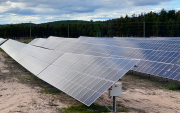As anticipated for many months now, the U.S. Environmental Protection Agency's (EPA) new regulations for industrial greenhouse gases (GHGs) took effect on January 2 (for background, see our previous blog posts for an initial assessment of the EPA regulations and a more recent review of Canada's response). And despite dire warnings from some U.S. industry lobby groups, the sky appears to have remained in place! This is hardly a surprise, given that requiring major new and modified facilities to apply the most energy efficient technology available (keeping in mind economic costs) is hardly a bank-busting proposition.
Just prior to Christmas, the EPA took a second important step forward in regulating industrial GHGs. After being sued by states and environmental groups for failing to fulfill its duties under the Clean Air Act, the EPA reached two settlements committing them to establish New Source Performance Standards (NSPS) for GHGs from power plants and refineries. (In the arcane terminology of the EPA, these "new source" standards will actually cover both new and existing facilities, as discussed in our background paper.) Power plants and refineries are the biggest and second-biggest industrial sources of GHG pollution in the U.S. respectively, and together account for nearly 40 per cent of its national emissions.
Existing sources to face emissions limits
The move to establish NSPS for two separate source categories signals that the EPA is moving forward carefully on GHGs. Rather than proposing a broader cap-and-trade system under the Clean Air Act (which many experts felt was possible but politically and legally risky), the EPA is opting to address major source categories one at a time — beginning with the most important ones. Regulation of existing facilities will be implemented by the states, and they will be free to implement it through cap-and-trade. California, for example, has already announced its intention to do this.
Apples, oranges and...inaction?
As the U.S. continues to move ahead, Canada's new Environment Minister, Peter Kent, has the unenviable responsibility of explaining why Canada — which pledged to "harmonize" or "align" its climate policy approach with the U.S. — is not yet keeping pace.
 In an interview on CBC's Power & Politics last week, Minister Kent said that Canada "will not follow [the EPA's] course," but "we are harmonizing in terms of the outcome....We will reach the same outcome." In other words, we have the same emissions target, but — for now at least — without having the policies required to get there.
In an interview on CBC's Power & Politics last week, Minister Kent said that Canada "will not follow [the EPA's] course," but "we are harmonizing in terms of the outcome....We will reach the same outcome." In other words, we have the same emissions target, but — for now at least — without having the policies required to get there.
The only industrial GHG regulations that Canada is currently preparing are for coal-fired power. In a recent Calgary Herald story, Minister Kent noted that comparing the importance of coal-fired power in Canada and the U.S. "really is apples and oranges." He is certainly correct about that, but this only serves to weaken the argument that regulating coal power is enough for Canada.[1] In regulating coal, U.S. regulators are going after their biggest sources of emissions. Canada must do the same if we are to have any hope of meeting our climate change targets. Right now, Canada's oil and gas sector accounts for 22 per cent of Canada's total emissions, and government forecasts show that it is projected to drive emissions growth in the coming decade. Emissions from coal-fired power, on the other hand, account for 13 per cent of Canada's emissions and are projected to drop even in the absence of new federal action, due to existing provincial policies.
On Power & Politics, Minister Kent acknowledged that regulations for other large emitters would eventually follow those for coal power, and that GHG rules for the oil and gas sector would be "a logical progression." But the minister gave no indication of when this next step might take place. Unless Canada takes steps quickly to reduce its industrial emissions, a "harmonization of outcomes" with the U.S. will become increasingly difficult to attain.
When it comes to regulating industrial emissions in Canada, it will take more than "staying the course" to honour our international commitment to cut climate change pollution by 17 per cent between now and 2020 — a goal the government insists it's determined to meet.
[1] With the notable exception of several provinces, such as Alberta, Canada as a whole is much less reliant on coal power than the U.S. is. In 2008, coal-fired power accounted for 13 per cent of Canada's emissions; in the same year it was 28 per cent of America's emissions. Moreover, with provincial policies already in place, coal's share of Canadian emissions is projected to fall to seven per cent of national emissions by 2020 under business as usual, while still accounting for 30 per cent of emissions in the U.S.







